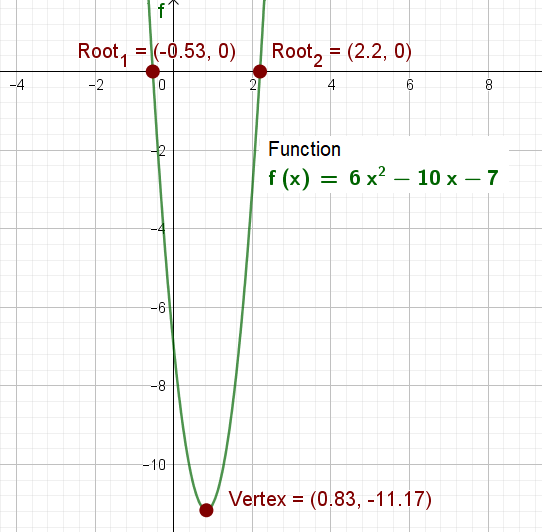Given:
#y= f(x) = (2x-1)^2+2 (x + 1) (x - 4) " " # Polynomial
#color(green)(Step.1#
We will expand and simplify
#y= f(x) = (2x-1)^2+2 (x + 1) (x - 4) #
as shown below:
First, consider #color(blue)((2x-1)^2#
Using the algebraic identify,
#color(brown)((a-b)^2 -= a^2 - 2ab - b^2#,
we can expand as shown:
#rArr (2x)^2 - 2(2x)*(1) + (1)^2#
#rArr 4x^2-4x+1 " "# Expression.1
#color(green)(Step.2#
Next, consider
#color(blue)(2 (x + 1) (x - 4) #
We can factor them out to obtain
#rArr 2*(x^2 - 4x+x-4)#
#rArr 2*(x^2 - 3x-4)#
#rArr 2x^2 - 6x - 8 " "# Expression.2
#color(green)(Step.3#
We will add our Expression.1 and Expression.2 to get #y#
# (4x^2-4x+1)+(2x^2 - 6x - 8)#
#rArr 4x^2-4x+1+2x^2-6x-8#
#rArr 6x^2-10x-7#
Now, we are in a position to re-write our Polynomial as
#color(blue)(y=f(x)=6x^2-10x-7#
#color(blue)(6x^2-10x-7=0# is our Quadratic Equation,
and we proceed to find the roots.
#color(green)(Step.4#
Now that we have a Quadratic Equation in the Standard Form
#ax^2 + bx + c = 0#, where
#a = 6; b = (-10) and c = (-7)#
We now use the Quadratic Formula to find the roots
#color(red)(Root_1,_2 = -b+- sqrt(b^2-4*a*c)/(2.a)#
#rArr [-(-10)+-sqrt((-10)^2-4(6)(-7))]/(2(6)#
#rArr [10+-sqrt(100-4(-42)]]/12#
#rArr [10+-sqrt(100+168]]/12#
#rArr [10+-sqrt(268]]/12#
#rArr 10/12+-sqrt(268)/12#
#rArr 10/12+-sqrt(4*67)/12#
#rArr 10/12+-sqrt(4)/12*sqrt(67)/12#
#rArr 5/6+-2/12*sqrt(67)/12#
#rArr 5/6+-(2sqrt(67))/12#
#rArr 5/6+-(cancel 2sqrt(67))/(cancel 12( color(red)(6))#
#rArr 5/6 +-sqrt(67)/6#
#rArr (5+-sqrt(67))/6#
Hence, we can write our roots as
#color(blue)(Root_1 = [5-sqrt(67)]/6, " " Root_2 = [5+sqrt(67)]/6 " "# (or)
#Root_1 = -0.53089, or Root_2 = 2.19756#
Please observe that these are our required real roots, as the discriminant #color(blue)((b^2-4*a*c)>0#
#color(green)(Step.5#
We will verify our solutions using GeoGebra graphing software




